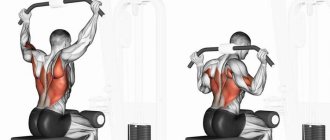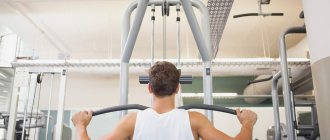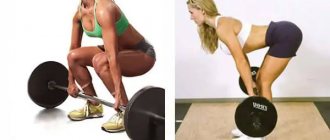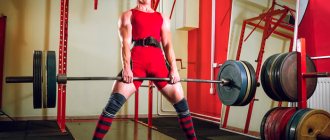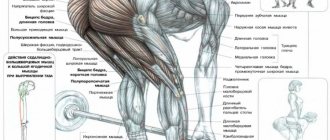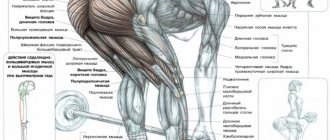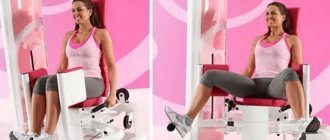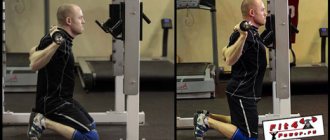Advantages and disadvantages of working in a vertical block
In continuation of what has been said about the safety of the simulator, I will clarify that the pull of the upper block does not load the spine, but, on the contrary, stretches the vertebrae thanks to the counterweight, which makes the exercise safe for diseases such as hernias, protrusions, pinched nerve endings, but only with moderate weight . Also, training on the upper block will be the right choice for beginners who have not yet strengthened their muscles, and performing barbell rows, dumbbells or other basic exercises can be traumatic.
This does not mean that exercises on a vertical block are completely safe.
If the technique is not followed, injuries to the shoulder joint are possible, which occur when the arms are sharply extended upward, which injures the joint capsule.
It is also possible to rupture the long head of the triceps , which is directly involved in bringing the arm to the chest. This can be caused by muscle overload due to excessive working weight at a time when the back muscles turn off and the triceps take on the entire load.
Following proper exercise technique and choosing the right weight will not only prevent injury, but will also improve your workout performance.
Vertical pull-down to the chest with an overhand grip
My favorite form of doing this exercise, and honestly the only one I do.
Some people like to make other shapes. I have nothing against it, because... Everyone's physiology and muscle structure are different. I always advise focusing specifically on the sensations of the muscles during the exercise.
If you feel them well, then, accordingly, the exercise suits you well; if you don’t understand where the load is going, then you need to work on the technique; if there is no effect here, then change the form of execution or the entire exercise.
That's sorted out. How to perform a vertical block row to the chest with a direct grip. Yes, very simple.
- We grab the handle of the machine with a DIRECT GRIP, slightly wider than shoulder width, i.e. MEDIUM GRIP. Usually the handle has bends on both sides, so take it a little wider than them.
- We press the upper parts of the thighs tightly against the rollers (the height of the rollers is usually adjustable).
- We position the body so that the cable from the handle moves strictly vertically.
- We bend in the lower back.
- Pull the handle towards you, FEELING YOUR BACK MUSCLES at every point of the amplitude! It is important. If you don’t feel the muscles, you “miss” the load. There will be no sense in the exercise.
- At the lowest point, the handle should be approximately near your pectoral muscles, try to make a PEAK CONTRACTION, creating additional tension in the back muscles.
- Do not drop the handle, lift it under control, maintaining tension in the muscles.
- Repeat the movement.
I consider this exercise in this particular form to be the best option, especially for beginners.
Wide grip lat pulldown to chest
The exercise develops back thickness by increasing the load on the middle of the latissimus muscles.
What muscles work
- Latissimus dorsi muscles.
- Teres major muscle.
- Biceps brachii.
- Shoulder muscles.
- Additionally included: trapezius muscle, rhomboid muscle, pectoralis major muscle.
Execution technique
- Place a wide handle on the upper block, grab it from above with a wide grip.
- Lower yourself into the seat with your arms extended above your head. Place your hips under the special fixing rollers.
- Lean your body back slightly, maintaining this position throughout the approach.
- As you exhale, bend your elbows and , using the efforts of your back muscles, bring your shoulder blades together , bringing the handle to the clavicular part of your chest, while protruding your chest, forming a deflection.
- Do not touch the sternum with the handle; fix the tension at the lowest point.
- As you inhale, smoothly straighten your elbows, maintaining the position of your body.
- At the top point, smoothly straighten your arms, gently stretching your shoulder joints, without jerking.
- Repeat the movement.
Upper pulley to the chest in video format
Vertical block thrust
The vertical (or overhead) pull-down is an accentuated BASIC exercise for the back muscles.
Basic because more than one joint is involved:
- Elbow.
- Brachial.
When performing this exercise, the latissimus dorsi muscles work perfectly, as well as a huge number of other muscles:
- Diamond-shaped.
- Trapezoidal.
- Big round.
- Large chest.
- Posterior part of the delta.
- Biceps.
- Etc.
This exercise is a kind of IMITATION of pull-ups.
The main difference is that when doing pull-ups, we pull our body towards the bar, and when performing a vertical pull-down, we, on the contrary, pull the bar towards our body.
What is the point of this exercise if there are classic pull-ups on the bar?
CONVENIENT load adjustment!
If you, say, weigh 70 kg, then your starting weight for pull-ups will start at 70 kg, which is not always convenient, because in most cases, beginners in the gym cannot do a single pull-up, and therefore such a useful movement as pull-ups turns out to be inaccessible.
An alternative, for starters, could be a vertical block pull.
Technique for performing vertical block rows
What to pay attention to when performing the exercise:
- Grip width.
- Body position.
- Bend in the lower back.
- Rollers.
- Form of the exercise.
First, I’ll explain about the GRIP WIDTH.
- THE NARROWER THE GRIP = Larger range of motion (this is good, because the back does a lot of work) + The BICEPS works more (this is bad, because we are doing this exercise for the back);
- THE WIDER THE GRIP = Less amplitude of movement (this is bad, because the back does less work) + The BACK is more involved in the work (this is good);
As you can see, if we take it VERY WIDE or VERY NARROW, then while we have certain advantages (larger amplitude, the back is more involved in the work), we also get disadvantages (smaller range of motion, the biceps work more).
Exit?
We need to look for the GOLDEN MEAN (not very broad, not very narrow).
The so-called would be almost ideal. MEDIUM GRIP (slightly wider than shoulder width), because We:
- Firstly, we maintain a sufficiently large range of motion.
- Secondly, we practically exclude biceps from the work.
Let's move on to the CASE POSITION.
You need to position yourself on the seat so that the cable from the handle is positioned STRICTLY VERTICAL! Those. you SHOULD NOT have such a deflection of the body that the cable moves towards you at an angle. It is not right!
Correctly, when you have taken such a position that, by pulling the crossbar (handle) towards you, the cable is positioned strictly vertically.
The fact is that the back is a huge muscle group, the muscles of which are located in two layers and can perform pulling movements towards themselves in different positions.
Depending, roughly speaking, where we pull from, those muscles turn on. That is why the back needs to be pumped with pulling movements VERTICAL + HORIZONTAL.
There is an opinion that vertical rows grow the back muscles in width, and horizontal rows in thickness. This is visually true, but the mechanism is a little different.
To put it very roughly, vertical rows actually use the back muscles, which are located mainly on the so-called. UPPER layer of muscles (latissimus, teres major, trapezius, etc.).
And the horizontal ones make you work, the so-called. The LOWER layer of back muscles (diamond-shaped, for example), which pushes out the rest of the back muscles, making it visually thicker. This is a purely mechanical point, which we will talk about in detail another time.
I told you about this so that you understand that our goal, with vertical rows, is to “get the load” into the LATISMUS dorsi muscles (which make it wider).
By leaning back when the cable is at an angle towards you, you remove the load from the latissimus muscles, directing it to the inner parts of the back, but not completely, because you are not pulling towards yourself at a right angle.
So it turns out that it’s neither here nor there.
This is beneficial for the body because it “spreads” the load over a larger number of muscles, without forcing itself into energy-intensive muscle growth.
Remember: the cable must be directed strictly vertically!
What's with the arch in the lower back?
There should be a deflection in the lower back!
You should kind of stretch your chest up.
However, there should be a deflection in the lower back in almost all exercises existing in bodybuilding, except, perhaps, the bench press and abdominal exercises.
By the way, I have a cool article in which I tell you how to quickly pump up your abs at home.
Remember: we bend in the lower back.
Next we'll talk about rollers. What is this anyway?
Most simulators have the so-called. rollers that you press against with the top of your thighs. It’s strange that these rollers are not available in all simulators.
It’s strange, because if your body (or rather, the fifth point) lifts off the seat of the exercise machine, then this allows you to remove the load from the back muscles, which you absolutely should not do (since muscle growth is not visible).
How to sit correctly in the exercise machine? The bolsters should PRESS YOU FIRMLY TO THE SEAT! Your butt should not come off, you should be focused on the movement of the handle towards you, feel the contraction of your back muscles.
Plus, do not forget about the position of the body, in which the cable should move strictly vertically towards you.
Get ready and calmly do the exercise.
The next thing is the form of doing the exercise.
You can do this exercise a little differently.
Here are some of the forms:
- Vertical pull-down with a straight grip.
- Pull of a vertical block behind the head.
- Reverse grip vertical block row.
- Parallel grip vertical block row.
I have listed only the main forms of performing this exercise; in fact, there are many more. The technique will be almost the same for everyone, so I don’t see much point in listing other types of this exercise.
Vertical block row for the head
The advantage of this exercise is to develop the width of the back muscles. This exercise prepares your back muscles for pull-ups and free weight exercises.
What muscles work
- Latissimus dorsi muscles.
- Teres major muscle.
- Biceps brachii.
- Shoulder muscles.
- Brachioradialis muscles.
- Lower part of the trapezoid.
- Rhomboid muscle.
Exercise technique
- Grab the wide handle with a wide grip from above, lower your pelvis onto the seat, straighten your arms above your head, lock your hips under the bolsters.
- Lean your body forward slightly, keeping your back straight.
- As you exhale, move the handle behind your head without touching the cervical vertebrae. Do not lower the handle below your neck. Bring your elbows towards your body by bringing your shoulder blades together, working concentratedly with your back muscles.
- Lock the muscles at the lowest point with maximum contraction.
- As you inhale, slowly straighten your arms above your head.
- Repeat the movement.
Pulldown of the upper block behind the head in video format
Vertical block row: how many times to do?
Beginners (and especially girls) are recommended to perform overhead rows of 12-15 repetitions and with a weight not exceeding half of their body weight. Increase the working weight only after you can clearly feel that it is the latissimus dorsi muscles that are doing the work in the exercise, and not the arms or other core muscles.
Remember that in order to pump up your back muscles, you first need to learn to feel them - otherwise you simply will not be able to consciously include them in your work. And in order to learn to feel your back, it is important to perform lat pulldowns with perfect technique, slowly and with adequate working weight - and not just chase records for speed or number of repetitions.
***
New Fitseven materials, 5 times a week - in telegram:
- fit7seven
The seated lat pull-down, a variation of pull-ups on a bar, is one of the basic exercises for developing back muscles. Common mistakes when performing this exercise include pulling at the head rather than the chest, using too much weight, and performing the movement at an excessively fast pace that does not allow the muscles to consciously engage the muscles in the work.
Reverse Grip Lat Pulldown
The exercise maximizes the thickness of the back muscles, especially the middle part. In this variant, the biceps of the shoulder are more involved in the work.
What muscles work
- Latissimus dorsi muscles.
- Teres major muscle.
- Rhomboid muscle.
- Pectoralis minor muscle.
- Shoulder biceps.
- Brachial muscle.
Exercise technique
- Place your palms on a wide bar, shoulder-width apart, with a reverse underhand grip, supinating your shoulder joints.
- Lower your pelvis onto the seat, lock your hips under the bolsters, slightly tilt your body back, maintaining the position throughout the approach.
- As you exhale, squeeze your shoulder blades, bringing your elbows towards your body, lower the handle to the upper part of the pectoral muscles, but do not touch them. Concentrating on the work of the back muscles, bring the shoulder blades towards each other as close as possible due to the deflection of the chest, in other words, make the chest a “wheel”.
- Try to perform the pull not with the biceps, but concentrated with the back muscles.
- As you inhale, smoothly straighten your arms at the joints, keeping your torso tilted back.
- Repeat the movement several times.
Reverse grip lat pulldown in video format
What muscles work when pulling the lower block?
The lower block row is aimed at working the back muscles in particular:
- Latissimus muscles. This is the target muscle group. And our task is to focus on their work.
- Rhomboid muscles (major and minor). Helps bring the shoulder blades closer to each other. When performing deadlifts, this is the main task, that is, we start the movement from the shoulder blades.
- Teres major and minor muscles. These muscles are more related to the shoulder girdle. Located on top, covered by the latissimus muscles. Responsible for shoulder extension. The small one is used more with a supinated grip (palms below), and the large one with a pronated grip (palms on top). If the grip is neutral (palms facing each other), then both muscles receive the same load.
- Trapezoid (in particular its lower and middle parts). Together with the rhomboid muscles, it helps to bring the shoulder blades together, which allows you to work with more weight.
Also, the muscles of the arms and shoulders work:
- Biceps. Bends the arms at the elbow, which helps to move it back as much as possible. If your goal is to pump only your back, then you need to learn to exclude the biceps from the exercise. But if you use pulley rows to develop your back and biceps, then you can safely use these two muscle groups at once.
- Rear delta. Pulls his shoulder back. Don't focus on their work. We will discuss how to do this further.
- Triceps.
More precisely, not the entire triceps, but its large head. It is stretched to its maximum when the arm is bent. It also helps move the arm back along with the rear deltoid.
Lower block traction
And of course, don’t forget about the stabilizers of our body:
- Abdominal muscles (rectus and obliques) and spinal extensors. They help keep our spine in an even position. Do not allow it to bend or unbend much.
- Leg muscles.
We rest them on special stands. They regulate the position of our body relative to the simulator (closer or further).
As you can see, the lat pulldown involves a very large number of muscle groups. But we can change the area of influence using a variety of grips.
Close-grip vertical pull-down (parallel)
The exercise works all parts of the latissimus dorsi and teres major muscles using a handle for a narrow parallel grip.
What muscles work
- Latissimus dorsi muscle.
- Teres major muscle.
- Biceps brachii.
- Brachial muscle.
- Brachioradialis muscle.
- Also involved: rhomboid and trapezius muscles, posterior bundles of deltoid muscles.
Features of the technology
- It is necessary to place a handle for a narrow parallel grip or an L-handle on the upper block.
- Grasp the handles and lower your pelvis onto the seat, securing your hips under the bolsters.
- Straighten your arms above your head, lengthening your spine.
- As you exhale, pull the handle toward your upper chest without touching. At the lowest point, it is important to form a deflection of the thoracic region , as if the chest is tending to the handle, bring the shoulder blades as close as possible to each other.
- As you inhale, gently release the tension, straightening your elbows completely.
- Repeat the movements.
Close-grip lat pull-down in video format
Is it possible to pump up your shoulders?
Regarding the last point, you should pay attention: with the help of such a pull, you won’t be able to pump up huge shoulders or chest. This exercise is intended to complement the work on the muscles, and not to become the basis for their growth. For girls who want to tighten their shoulders, this is an ideal option. But men should supplement their work with other basic exercises. An alternative to traction can be:
- pulling the lower block in turn with a wide stance;
- pull-ups with various grips;
- chest pull using an overhead pulley;
- pull to the belt.
The lat pulldown using a rope handle is a good way to add to your arsenal of exercises for the shoulders, chest, and back. It is suitable for girls, novice athletes or people during the rehabilitation period. It will not be possible to pump up a large volume only with the help of such traction, but it is definitely possible to create relief. The exercise is of medium difficulty level and has options for execution. Deadlifts will add variety and improvement to your workout. See you in the new blog! Subscribe to updates and invite friends!
One-arm lat pulldown
This exercise will allow you to work your back muscles more effectively. When performing the exercise on one side, the weight is not distributed on both hands, but focuses on the target muscles without the help of the stronger hand. Therefore, the craving becomes more concentrated. When choosing a working weight, divide the load with which you perform two-arm rows by two. For this exercise you will need a one-handed handle or a D-handle.
What muscles work
- Latissimus dorsi muscles.
- Teres major muscle.
- Biceps brachii.
- Shoulder muscles.
- Brachioradialis muscles.
- Lower part of the trapezius muscle.
- Rhomboid muscle.
Features of the technology
- Secure and grip the handle for one hand.
- Stand sideways, turning away from your working hand, and lower your pelvis onto the seat, while you can fix one thigh with a bolster, if this is convenient.
- Straighten your arm completely, and exhale, lower the handle to your shoulder, bringing your shoulder blade closer to the center of your back and your elbow closer to your torso. In this case, the shoulder should not turn, the elbow should look down.
- As you inhale, smoothly extend your arm to the starting position and repeat the movement.
- Then turn around in the other direction and repeat the same movement.
Seated one-arm lat pulldown in video format
Vertical row on the block with one hand
Making a difference
What sets this movement apart from others is that it is unilateral, which promotes balanced muscle development (on each side); if one side of the lats is lagging behind the other, regular one-arm rows will allow the weaker side to grow and catch up with the stronger side.
Read also: 3 exercises to create a thicker back.
Performance
Attach the D-handle to the cable of the machine. While seated, grasp the handle with one hand and begin by keeping your torso straight with your palm facing the midline of your body (neutral). Place your non-working hand on top of the knee support bar. Bend your elbow and pull the handle down until your arm is below chest level. Slowly return to arm's length position. Repeat the movement as many times as necessary, then change hands.
What is better to do – pull-ups or lat pull-downs?
First, you need to understand that pull-ups are the pinnacle of perfection in physical fitness and not everyone can do it for various reasons. While everyone can perform lat pull-downs - both men and girls.
The vertical block row will be an excellent springboard in preparation for pull-ups, since the target muscles in these exercises are almost the same, the only difference is in the strength and capabilities of the athlete.
If we talk about effectiveness, of course, pull-ups involve more muscles, require more strength and endurance from the athlete and bring him closer to results - increased strength, muscles and endurance.
If pull-ups are feasible at least 2-3 times, they should be included in training and developed, and various rows will be additional exercises in the uniform development of the back muscles. Otherwise, rows will be the only way to strengthen your back until the muscles are ready for pull-ups.
And also read, leading exercises to pull-ups →
Who is suitable for lat pulldowns with straight arms?
So, we have already determined that this exercise belongs to the category of additional ones, allowing us to focus the training on specific muscles.
Who should include lat pulldowns with straight arms in their program:
- First of all, for those who want to quickly pump up a wide back
- those who want to strengthen their torso and work out their deltoids
- for those who do not like to “pull iron”, but want to achieve muscle growth
Technique: wide grip vertical row
1. Adjust the height of the leg bolsters on the horizontal row machine so that they firmly support your hips, preventing them from lifting off the bench during the exercise. The pelvis should be positioned on the seat so that the upper block and bar are in front of the chest (and not directly above the head).
2. Raise yourself slightly, grab the ends of a long bar with an overhand grip, pull the bar down, sit on the machine seat and place your hips under the bolsters.
3. Starting position: the torso and arms are fully straightened, and the shoulders are raised. The position of the body resembles the letter “U”. The thighs are firmly fixed between the seat and the bolsters, the feet rest on the floor.
4. Tighten the lumbar muscles and do not relax them until the end of the set - they are the ones who ensure that the torso is kept in a straight position.
5. Take a deep breath and hold your breath. Tighten your lats and, squeezing your shoulder blades, pull the bar straight down.
6. Elbows move strictly parallel along the sides and are directed back and to the sides. When the bar is at shoulder level, pause and tighten your lats even more. Smoothly return the bar to its original position.
7. At the top, pause again - this will help to better stretch the lats. Proceed to the next repetition.
Wide Grip Vertical Row - Muscles
